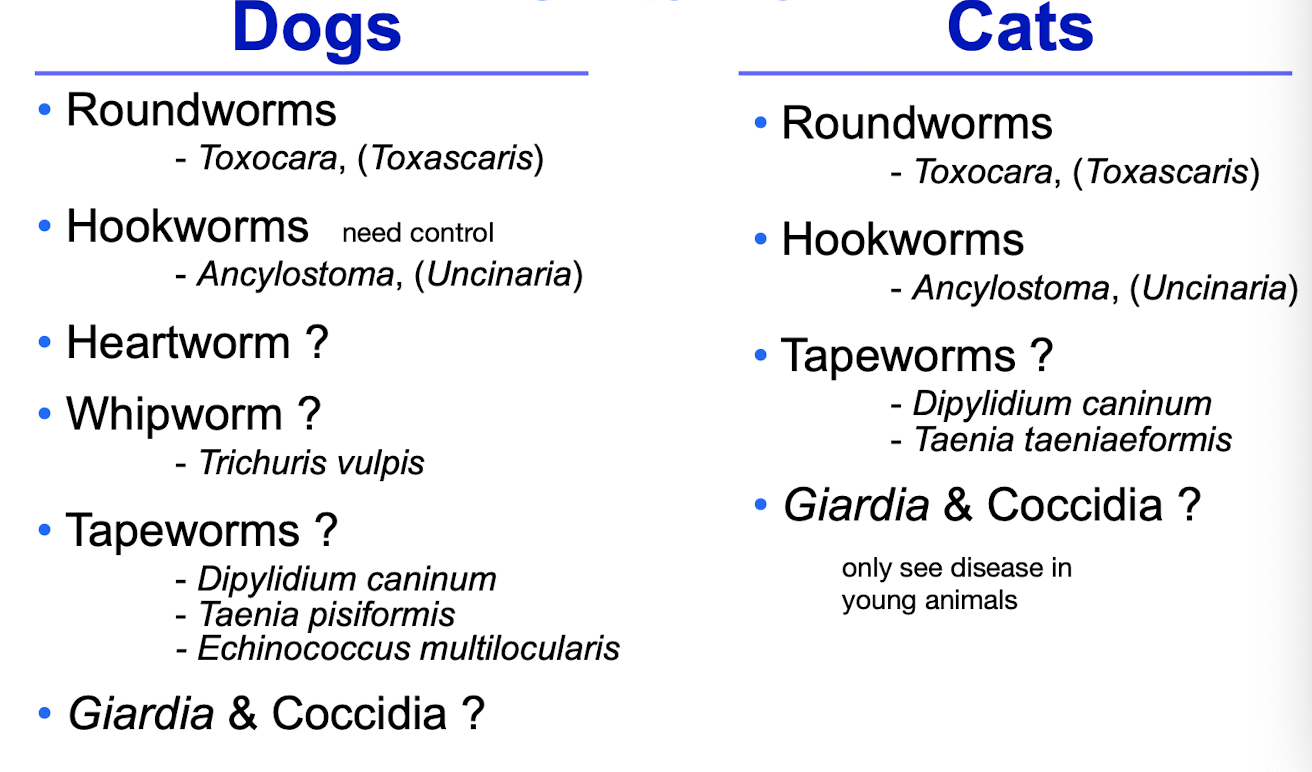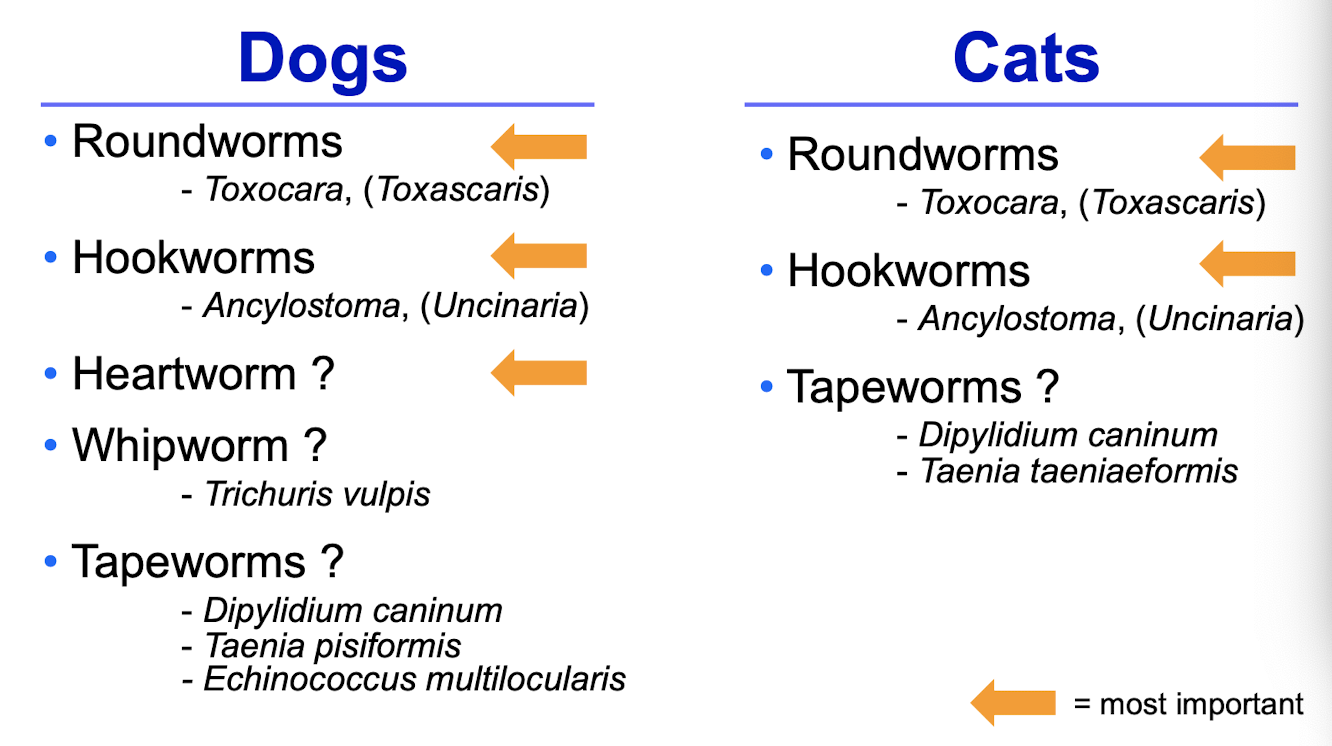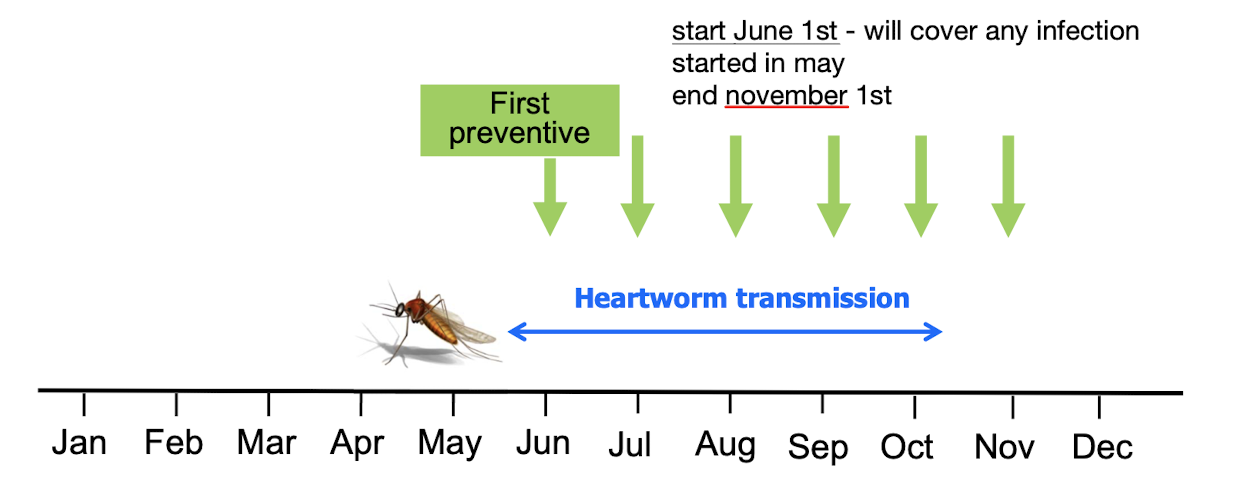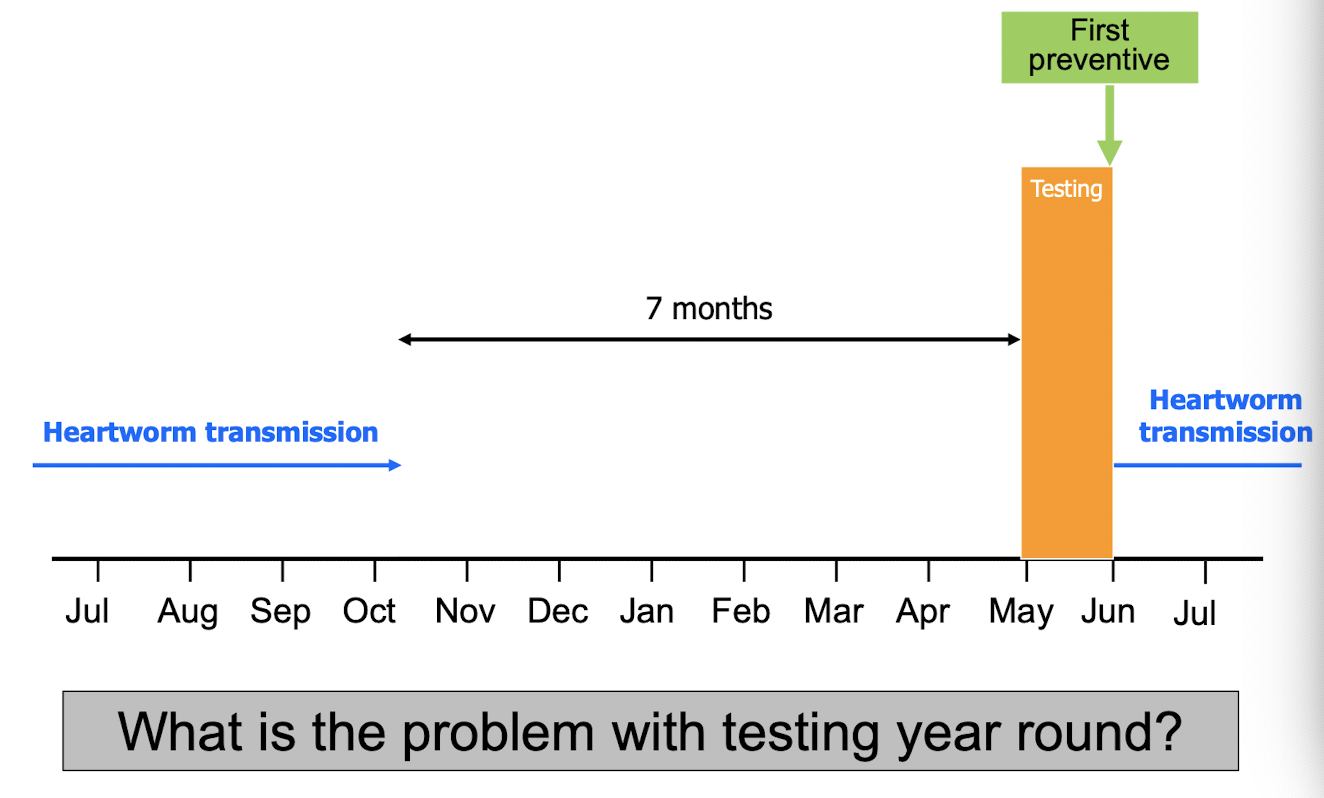Parasitology
1/30
There's no tags or description
Looks like no tags are added yet.
Name | Mastery | Learn | Test | Matching | Spaced |
|---|
No study sessions yet.
31 Terms
What 3 major questions should clinicians ask before designing a parasite control program?
What parasites occur in the local small-animal population?
Is parasite control justified? (risk of infection, disease potential, zoonotic risk, local zoonotic pressure, clinician’s own risk tolerance)
What control program should be implemented?
What additional considerations affect the choice of parasite control program?
Client risk aversion
Financial constraints
Downsides or limitations of the program (e.g., side effects, compliance, cost, environmental impact)
What are the key endoparasites of dogs and cats in Ontario?
Dogs: roundworms, hookworms, heartworm (?), whipworm, tapeworms, Giardia, coccidia.
Cats: roundworms, hookworms, tapeworms, Giardia, coccidia.
Species include Toxocara, Ancylostoma, Dipylidium, Taenia, and Echinococcus (dogs)

What are the primary ectoparasites of dogs and cats in Ontario?
Fleas
Ticks (Dermacentor variabilis, Ixodes scapularis), animals need to be outside in the grass
Otodectes (in cats)
What principles guide appropriate use of antiparasitic drugs?
Use the narrowest spectrum drug possible.
Use a route that ensures compliance.
Use as few products as possible.
Treat only when the animal is at risk.
Monitor efficacy routinely
Which human groups are at highest risk for parasitic zoonoses, and how should this influence deworming?
YOPIs: young children, older adults, pregnant individuals, immunocompromised patients.
These households should follow more aggressive preventive deworming strategies
Which two parasites are NOT routinely targeted by preventive treatment in dogs/cats?
Giardia → common but subclinical
466 dogs ≥6 months old
Giardia prevalence: 11.8%
More common in <1-year-olds
>95% had no diarrhea (subclinical)
Coccidia
Because subclinical infections are common and typically don’t justify routine treatment
Do Giardia infections in Ontario dogs and cats present significant zoonotic risk?
Mostly no—because genetic assemblages infecting pets are largely host-specific and not the zoonotic A/B assemblages
Which Giardia assemblages affect dogs and cats, and are they zoonotic?
Dogs: C, D (dog-specific, non-zoonotic)
Cats: F (cat-specific, non-zoonotic)
Zoonotic: A & B (infect humans + multiple hosts)
Thus >98% of dog infections in Ontario are not zoonotic
What are the major takeaways regarding Giardia infections in Ontario dogs/cats?
98% of dog infections are dog-specific.
Most cases are subclinical.
Do NOT treat subclinical infections unless zoonotic concern and genotyping cannot be done
How should Giardia be treated when clinical disease is present?
Fenbendazole(use this)
Metronidazole(approved for dogs, but is broad spectrum and can lead to resistance)
Reinfection from environment/coat is common
Treat all animals, bathe on day 1 and last day, clean environment, reduce stress
Should healthy animals be screened for Giardia and how can infection be prevented?
Routine monitoring not justified for healthy animals.
Prevention: keep animal & environment clean and dry; cysts lose infectivity with dryness and freeze-thaw cycles
What animals are most at risk for coccidiosis Cystoiosospora and what factors trigger disease?
Mostly affects dogs <6 months
Triggered by stress: weaning, overcrowding, travel, rehoming
Ideal environment for outbreaks: kennels
Treatment: sulfas, TMS, amprolium, toltrazuril (all off-label)
What are important environmental control strategies for coccidia?
Daily feces removal
Keep floors clean and dry
Oocysts resistant to disinfectants → use steam/pressure wash, hot water
Consider sealing floors
How should subclinical coccidia infections be handled?
Typically not treated so immunity can develop naturally
What is the most important intestinal parasite in cats in Ontario?
Roundworms (Toxocara spp.) are the most significant

What are the 5 major preventive areas for small animals?
Heartworm
Intestinal parasites
Fleas
Ticks
Wellness plans
What lifecycle stage do heartworm preventives target?
They target L3/L4 larvae acquired during the previous month. Preventives work with 1-month “reach-back” activity
What factors determine whether a dog needs heartworm prevention?
Local risk (geography).
Travel history.
Client risk tolerance
What drug classes are used for oral, topical, and injectable heartworm prevention?
Oral: ivermectin+pyrantel, milbemycin(+praziquantel)

Topical: selamectin, moxidectin+imidacloprid.
Injectable: moxidectin (6 or 12-month).
Spectrum varies widely (fleas, ticks, GI parasites)
What does interceptor used for?
Milbemycin → Dirofilaria, Toxocara, Toxascaris, Ancylostoma, Trichuris
Praziquantel → D. caninum(eating fleas), T. pisiformis, E. multilocularis (eating rodents)
Why might dogs require monthly praziquantel?
To prevent Echinococcus multilocularis egg shedding if they ingest infected rodents—important in high-risk regions/households
What parasites does revolution?
Selamectin
Heartworm
Toxocara
What parasites does Proheart 6 cover?
Heartworm
Ancylostoma
Uncinaria
When should heartworm prevention start and end in Canada?
Start: Within 1 month after transmission season begins
End:
Most products: 1 month after transmission season ends
Interceptor Plus / NexGard SPECTRA: 6 months after season.
Credelio PLUS: 2 months after season.
If transmission >6 months → year-round prevention

If a puppy is born in July in a heartworm-risk area, when should it get its first dose?
At ~8 weeks old (typically August–September), within the seasonal prevention window
What is the minimum age to test for heartworm antigen and why?
7 months old, because antigen is not detectable until worms mature (≈6–7 months post-infection)
How often should dogs be tested for heartworm?
At first visit if >7 months.
Annually if following label instructions (USA recommendation).
Less frequent = off-label, must justify based on low risk + informed consent

What steps should be taken if a dog tests heartworm antigen positive?
Repeat test using fresh sample.
Perform microfilaria test (Knott’s or Difil).
Assess travel and compliance history.
Evaluate for true infection vs. false positive/imported case
What additional diagnostics are recommended for dogs that test positive?
Evaluate travel/compliance history.
If clinical signs present:
Thoracic radiographs
Echocardiography
To assess cardiopulmonary impact
Goes to the R heart: immature adults enter the venous bloodstream, which returns blood to the right atrium → right ventricle → pulmonary arteries
What clinical signs occur in heartworm-infected dogs?
Usual: exercise intolerance, coughing, dyspnea.
Severe: weight loss, hemoptysis, ascites, hydrothorax.
Signs depend on worm burden + activity level